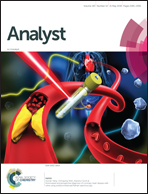Retracted Article: Rhodium nanocubes and nanotripods for highly sensitive ultraviolet surface-enhanced Raman spectroscopy†
Abstract
We report the shape- and wavelength-dependent ultrasensitive label-free detection of adenine on rhodium cube- and tripod-star-like nanoparticles (Rh NPs) using ultraviolet surface-enhanced Raman scattering (UV-SERS). Rh NPs immobilized on a silane-treated glass substrate probed at near-resonant and non-resonant wavelengths served as the SERS platform for the highly reproducible, stable, and real-time detection of adsorbed adenine molecules in the femtomolar region. The sensitivity of SERS-active Rh NPs displaying LSPR in the UV region was exploited for the 266 nm (DUV), 325 nm (UV) and 532 nm (visible) Raman excitation wavelengths. With the 266 nm and 325 nm DUV-UV excitation lines, for the Rh tripod geometry near or pre-resonant excitation being closer to the analyte absorption band combined with the intrinsic UV-LSPR resonant energy produced a SERS enhancement factor as high as 105 and accelerated photoinduced degradations compared to 532 nm for our substrates. Computational results consistent with the experiment clearly demonstrated that the NP SERS enhancement was sensitive to both the intrinsic optical properties of Rh in the UV region and the excitation closer to the LSPR peak producing larger EM enhancements. The wavelength-dependent correlations between the optical properties of the shape-tailored Rh NPs and SERS enhancements envisage the merit and demerit of DUV-UV excitation over visible excitation for Raman measurements. The as-fabricated SERS substrate could also be efficiently recycled using O2 plasma for the detection of other biomolecules. The use of oxide-free transition metal Rh and DUV-UV excitation thereby extends the improved generality of the SERS technique for ultrasensitive bimolecular detection and for gaining a comprehensive understanding of UV-SERS-based applications.



 Please wait while we load your content...
Please wait while we load your content...